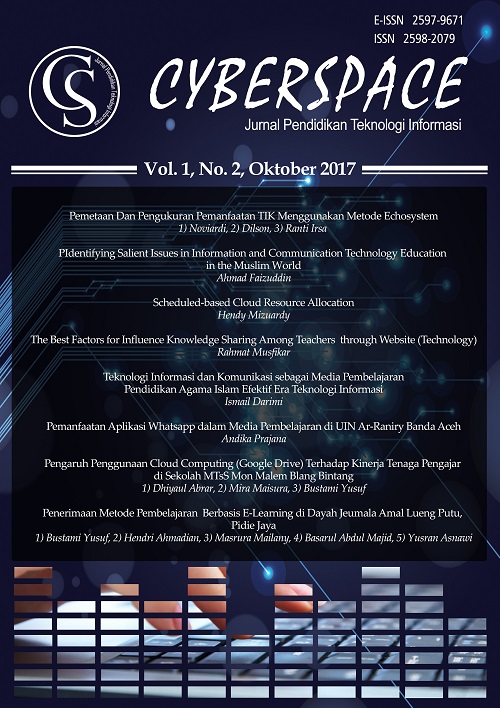INFORMATION AND COMMUNICATION TECHNOLOGIES SEBAGAI MEDIA PEMBELAJARAN PENDIDIKAN AGAMA ISLAM EFEKTIF ERA TEKNOLOGI INFORMASI
DOI:
https://doi.org/10.22373/cs.v1i2.2030Keywords:
Information Communication and Technology (ICT), Instructional MediaAbstract
Adapting to the technological era, learning activities are required to reduce the use of lecture methods and can be enriched in the use of instructional media, the role of learning media becomes increasingly important. ICT is a program, for tools, manipulation and convey information. The learning process of PAI can further facilitate the search for information, manipulation, management and transfer of science or transfer of information, so that the integration of ICT in the learning process becomes an important role in developing students' thinking ability, developing skills in the field of ICT to smooth the learning process, ICT especially in PAI lessons, and transforming schools into creative and dynamic learning institutions so that students are motivated, always curious in PAI learning. Broadly speaking media can be classified into graphics, audio, silent projections, games and simulations. Effective learning requires good planning of one of the media that will be used in the learning process. ICT is a very effective medium in learning PAI in the era of technologyReferences
Arief Sadiman, Media Pendidikan, Jakarta: Raja Grafindo Persada, 2008.
Azhar Arsyat, Media Pembelajaran, Jakarta: Raja Grafindo Persada, 2006.
Hamzah B. Uno dan Nina Lamatenggo, Teknologi Komunikasi dan Informasi Pembelajaran, Jakarta: Bumi Aksara, 2010.
Hujair Sanaky, Media Pembelajaran, Yogyakarta: Safiria Insania Press, 2009.
Ivor K. Davies, Pengelolaan Belajar, Jakarta: Rajawali, 1991
Lestari, Bela Oktama. Museum Ilmu Dan Teknologi Untuk Anak-Anak Di Solo Baru. Diss. Universitas Muhammadiyah Surakarta, 2013.
Mawar, Ramadhani. Efektivitas Penggunaan Media Pembelajaran E-learning Berbasis Web Pada Pelajaran Teknologi Informasi dan Komunikasi Terhadap Hasil Belajar Siswa kelas X SMA Negeri 1 Kalasan. Diss. Universitas Negeri Yogyakarta, 2012.
Miningsih, Sri. "Implementasi TIK dalam Pembelajaran Mendengarkan di Sekolah Dasar."Jurnal Teknodika 1.1 (2015).
Misbahruddin, A. "Pemanfaatan Teknologi Informasi Dan Komunikasi (TIK) Oleh Rumah Tangga Untuk Kehidupan Sehari-Hari."Jurnal Penelitian Pers dan Komunikasi Pembangunan 18.1 (2016).
Munawaroh, Isniatun. "Pemanfaatan Teknologi Informasi dan Komunikasi Untuk Menumbuhkan Kreativitas dan Kemandirian Belajar."Universitas Negeri Yogyakarta (2010).
Nana Sudjana dan Ahmad Rival, Media Pengajaran, Bandung: Sinar,1998.
Nurseto, Tejo. "Membuat media pembelajaran yang menarik."Jurnal Ekonomi & Pendidikan 8.1 2012
Ramayulis, Ilmu Pendidikan Islam, Jakarta: Kalam Mulia, 2004.
Sudarwan Danim, Media Komunikasi Pendidikan, Jakarta: Bumi Aksara, 2010.
Supriyanto, Wahyu, and Ahmad Muhsin. Teknologi informasi perpustakaan. Kanisius, 2008.
Yusuf hadi Miarso, Menyemai Benih Teknologi Pendidikan, Jakarta: Kencana, 2007.
Downloads
Published
Issue
Section
License
Authors who publish with Cyberspace Journal agree to the following terms:
- Authors retain copyright and grant the journal right of first publication with the work simultaneously licensed under a Creative Commons Attribution License that allows others to share the work with an acknowledgement of the work's authorship and initial publication in this journal.
- Authors are able to enter into separate, additional contractual arrangements for the non-exclusive distribution of the journal's published version of the work (e.g., post it to an institutional repository or publish it in a book), with an acknowledgement of its initial publication in this journal.
- Authors are permitted and encouraged to post their work online (e.g., in institutional repositories or on their website) prior to and during the submission process, as it can lead to productive exchanges, as well as earlier and greater citation of published work (See The Effect of Open Access).



















